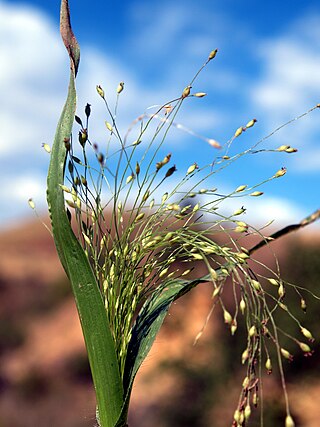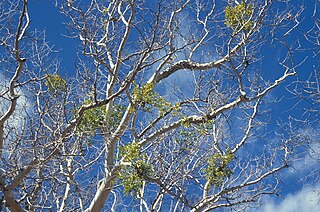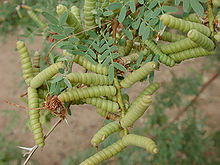
Mesquite is a common name for some plants in the genus Prosopis and Neltuma, both of which contain over 40 species of small leguminous trees. They are native to dry areas in the Americas. They have extremely long roots to seek water from very far under ground. As a legume, mesquites are one of the few sources of fixed nitrogen in the desert habitat. The trees bloom from spring to summer. They often produce fruits known as "pods". Prosopis spp. are able to grow up to 8 metres (26 ft) tall, depending on site and climate. They are deciduous and depending on location and rainfall have either deep or shallow roots. Prosopis is considered long-lived because of the low mortality rate after the dicotyledonous stage and juveniles are also able to survive in conditions with low light and drought. The Cahuilla indigenous people of western North America were known to eat the seeds of mesquite.

Prosopis is a genus of flowering plants in the family Fabaceae. It contains around 45 species of spiny trees and shrubs found in subtropical and tropical regions of the Americas, Africa, Western Asia, and South Asia. They often thrive in arid soil and are resistant to drought, on occasion developing extremely deep root systems. Their wood is usually hard, dense and durable. Their fruits are pods and may contain large amounts of sugar. The generic name means "burdock" in late Latin and originated in the Greek language.

Neltuma juliflora , formerly Prosopis juliflora, is a shrub or small tree in the family Fabaceae, a kind of mesquite. It is native to Mexico, South America and the Caribbean. It has become established as an invasive weed in Africa, Asia, Australia and elsewhere. It is a contributing factor to continuing transmission of malaria, especially during dry periods when sugar sources from native plants are largely unavailable to mosquitoes.

Hesperocyparis bakeri, previously known Cupressus bakeri, with the common names Baker cypress, Modoc cypress, or Siskiyou cypress, is a rare species of western cypress tree endemic to a small area across far northern California and extreme southwestern Oregon, in the western United States.

Myrica californica is an evergreen shrub or small tree native to the Pacific Ocean coast of North America from Vancouver Island south to California as far south as the Long Beach area.

Neltuma glandulosa, formerly Prosopis glandulosa, commonly known as honey mesquite, is a species of small to medium-sized, thorny shrub or tree in the legume family (Fabaceae).

Nassella pulchra, basionym Stipa pulchra, is a species of grass known by the common names purple needlegrass and purple tussockgrass. It is native to the U.S. state of California, where it occurs throughout the coastal hills, valleys, and mountain ranges, as well as the Sacramento Valley and parts of the Sierra Nevada foothills, and Baja California.

Prosopis velutina, commonly known as velvet mesquite, is a small to medium-sized tree. It is a legume adapted to a dry, desert climate. Though considered to be a noxious weed in states outside its natural range, it plays a vital role in the ecology of the Sonoran Desert.

Yuma Crossing is a site in Arizona and California that is significant for its association with transportation and communication across the Colorado River. It connected New Spain and Las Californias in the Spanish Colonial period in and also during the Western expansion of the United States. Features of the Arizona side include the Yuma Quartermaster Depot and Yuma Territorial Prison. Features on the California Side include Fort Yuma, which protected the area from 1850 to 1885.

Arctostaphylos silvicola is a species of manzanita known by the common names Bonny Doon or silverleaf manzanita. It is endemic to the sandhills of the southern Santa Cruz Mountains in California's Santa Cruz and Santa Clara counties.

Atriplex lentiformis is a species of saltbush.

Panicum capillare, known by the common name witchgrass, is a species of grass. It is a native plant to most of North America from the East Coast through all of the West Coast and California. It can be found as an introduced species in Eurasia, and as a weed in gardens and landscaped areas. It grows in many types of habitat.

Crepis acuminata is a North American species of flowering plant in the family Asteraceae known by the common name tapertip hawksbeard. It is native to the western United States where it grows in many types of open habitat.

Celtis reticulata, with common names including netleaf hackberry, western hackberry, Douglas hackberry, netleaf sugar hackberry, palo blanco, and acibuche, is a small- to medium-sized deciduous tree native to western North America.

Phoradendron macrophyllum is a species of flowering plant in the sandalwood family known by the common names Colorado Desert mistletoe, bigleaf mistletoe, and Christmas mistletoe. It is native to western United States and northern Mexico from Oregon to Colorado to Texas to Baja California, where it grows in many types of wooded habitat at elevations up to 1700 m.

Prosopis strombulifera is a species of mesquite or algarrobo, a shrub in the legume family. It is known by the English common names Argentine screwbean and creeping screwbean and the Spanish common name retortuño. This shrub is native to Argentina, where it grows in arid and saline soils. It became well known in California after it was introduced to Imperial County and took hold in the wild, growing as an invasive noxious weed. The plant grows from a network of long, spreading roots and may grow to three meters in height. Many plants may grow together in an area, forming a monotypic stand. The shrub has waxy-textured leaves made up of a pair of leaflets which are each divided into several pairs of secondary leaflets each up to a centimeter long. Whitish spines up to 2 cm long appear near the leaf bases. The inflorescence is a spherical head of many very narrow tubelike yellow flowers, the head measuring about 1.5 cm wide. The fruit is a bright yellow seed pod coiled tightly into a cylindrical stick up to 5 cm long. It contains several greenish seeds, each about 0.5 cm long.

Angelica capitellata, synonym Sphenosciadium capitellatum, is a species of flowering plant in the family Apiaceae. When treated as Sphenosciadium capitellatum, it was the only species in the monotypic genus Sphenosciadium. It is known by the common names woollyhead parsnip, ranger's buttons, button parsley, and swamp white heads.

Mesquite flour is made from the dried and ground pods of the mesquite, a tree that grows throughout Mexico and the southwestern US in arid and drought-prone climates. The flour made from the long, beige-colored seedpods has a sweet, slightly nutty flavor and can be used in a wide variety of applications. It has a high-protein, low-glycemic content and can serve as a gluten-free replacement for flours that contain gluten.

Thysanocarpus radians is a species of flowering plant in the family Brassicaceae known by the common name ribbed fringepod. The plant is also colloquially known as spokepod because of its seedpods’ characteristic resemblance to tire spokes. It is native to northern and central California and Oregon, where it grows in moist meadows, fields, hillsides, and other habitat. It is an annual herb growing up to 50 or 60 centimeters tall. The leaves are wavy-edged or lobed, the basal ones up to 5 centimeters long and ephemeral, and the upper ones with bases clasping the stem. The inflorescence is a long, open raceme of small whitish or purplish flowers. The fruit is a flattened, rounded, disclike capsule which hangs from its pedicel. It measures up to a centimeter long and is hairless to quite hairy in texture. The flat wing lining the edge of the disc is ribbed with rays like the spokes of a wheel, a characteristic making it easily distinguished from other Thysanocarpus when it is in fruit.

Ziziphus obtusifolia is a species of flowering plant in the buckthorn family known by several common names, including lotebush, graythorn, gumdrop tree, and Texas buckthorn.























